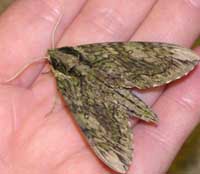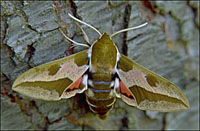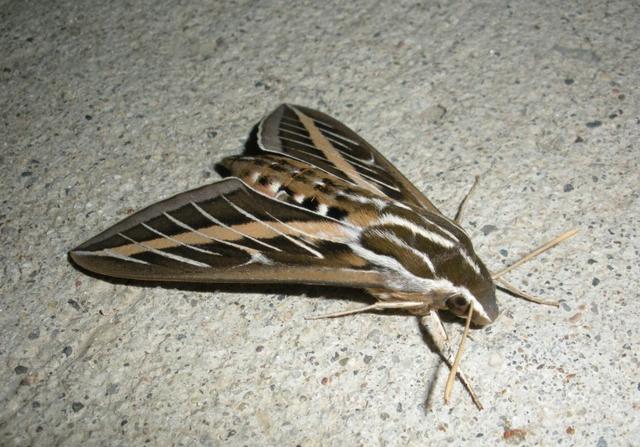Sphinginae subfamily
Sphingini tribe:
 |
Ceratomia amyntor
TJ,
the Elm Sphinx or Four-horned Sphinx
The upperside of the forewing is brown with dark brown and white
markings including a white costal area near the wing base, dark
streaks along the veins, and a white spot in the cell.
Larvae feed on Elm (Ulmus), birch (Betula), basswood (Tilia), and
cherry (Prunus). |
Ceratomia amyntor, larva on American Elm, August 1, 2009, Thomas Jantscher
 |
The upperside of the forewing is yellowish brown with no white
markings, but there are indistinct black lines and dashes. The cell
spot is gray with a black outline and the upperside of the hindwing
is yellowish brown with obscure lines.
Catalpa is the larval host. |
 |
Ceratomia hageni
WO,
Hagen's Sphinx or Osage Orange Sphinx
The upperside of the forewing is gray with a green tint and has dark
indistinct wavy lines, and pale gray patches at the wing tip and
along the costa. |
 |
The upperside of the forewing is pale brownish gray with wavy black
and white lines and a black-outlined white cell spot. |
Ceratomia undulosa, larva on Green Ash, July 6, 2009, Thomas Jantscher
 |
The upperside of the forewing is gray-brown with wavy lines, black dashes, and
one or two small white spots near the center of the costa.
|
 |
This large bodied moth flies in tobacco fields and vegetable gardens
(potatoes, tomatoes) and wherever host plants are found. |
Manduca quinquemaculatus at storage building light, October 10, 2010, Thomas Jantscher.

|
The upperside of the hindwing is banded with black and white and has
two black zigzag median lines that are very close together with
hardly any white showing between them
Larvae get very large and can strip a tomato plant.
|
 | The upperside of the forewing is gray with indistinct black and
white markings. There is a series of black dashes
from the base to the tip, and a small white cell spot.
|
 |
Sphinx chersis
WO, the Northern Ash
Sphinx or Great Ash Sphinx
The upperside of the forewing is soft dark gray to blue-gray with a series of black dashes,
one of which reaches the wing tip. |
 |
Forewings, long and slender, are held close to the body when the
moth is at rest. We have them on P.E.I.,
but I do not see them nearly as frequently as I see the other Sphingidae. |
 |
The lower forewings are predominantly brownish-yellow with a fairly
wide dark bar along the inner margin. At rest the wings hug the body,
giving the moth a long slender look.
|
 |
Snowberry Sphinx adults fly as a single brood in montane woodlands and along prairie
streamcourses from April to August.
The upperside of the forewing has a narrow black subterminal line
bordered by a white inverted V-shaped line on the outside, and a
black line at the apex.
|
Smerinthini Tribe:
 |
The adults are also highly variable; sometimes wings of an individual
may be all one color or may have several colors, ranging from pale to
dark brown, and may have a white or pink tinge.
See the file for the female; she is different. |
Amorpha juglandis, larva on Walnut, July 10, 2009, Thomas Jantscher
 |
Pachysphinx modesta; WO,
the Modest Sphinx or Poplar Sphinx,
This moth has a large, heavy body, and
females can be remarkably plump.
|
 |
The outer margin of the forewing is quite wavy. There is a dark cell spot and a dark oblique line mid wing from the costa almost to the
inner margin. Basic ground colour is pinkish brown. Flight would be June-July. |
 |
This small species is probably widespread and common. This species ranges across North America.
The hindwings have a small blue eyespot ringed with black on a yellow background.
|
 |
This moth is widely distributed and fairly common.
Along the East Coast, it flies from P.E.I. to Florida. |
Macroglossinae subfamily
Dilophonotini Tribe:
See Hemaris comparison
to help distinguish the next three species.
 |
Hemaris diffinis
WO, the Snowberry Clearwing or Bumblebee Moth,
The moth flies along forest edges and in meadows, gardens and
brushy fields. Day-flying adults nectar at lantana, dwarf bush honeysuckle,
snowberry, orange hawkweed, thistles, lilac, Canada violet, etc.
|
 |
Hemaris thysbe
WO, the Hummingbird Clearwing
This interesting day flier is not confirmed for Winneshiek.
They are widely distributed in the east from P.E.I. to Florida. |
Philampelini Tribe:
 |
This moth is not reported for Greene County, but I suspect it is present. It is fairly often
reported along the east coast from southern New Jersey
to central Maine.
Note the differences between this moth and the Pandorus Sphinx. |
 |
If you have Grape or Virginia Creeper nearby, then you probably have
this species. I often get asked to identify larvae from areas where
they have not previously been reported.
|
Macroglossini Tribe:
 |
This day flier is widely distributed. If you have Virginia Creeper,
you probably have the Nessus Sphinx. Two bright, distinct, narrow
yellow bands are often visible on the abdomen.
|
 |
Darapsa myron
WO, the Virginia Creeper Sphinx or the
Grapevine Sphinx
This moth is not recorded on the U.S.G.S. site for Greene County,
but it should be present.
It is widely reported as far north as southern Maine. If you have the
foodplants indicated in the common names, you probably have this
species nearby. |
 |
The moth's outer margin of the forewing is deeply scalloped.
The upperside is light brown with dark brown markings.
There is a small black and white spot near the tip.
The upperside of the hindwing is orange-brown with a dark brown
outer margin and median line.
|
 |
Hyles euphorbiae
WO, questionable, the Spurge Hawk Moth
The body is light brown with various white and dark brown
markings, while the wings have a conspicuous tan, brown, and pink or
red color pattern.
|
 |
Hyles gallii
WO, the Bedstraw Hawk Moth
or Gallium Sphinx
Some years I see them on P.E.I., some years, I do not.
|
 |
Hyles lineata
TJ, the White-lined Sphinx
Adults usually fly at dusk, during the night, and at dawn, but they
also fly during the day over a wide variety of open habitats
including deserts, suburbs, and gardens. |
Hyles lineata, at building MV light, June 14, 2009, Thomas Jantscher.
 |
This moth is very much under reported on USGS. It is a
rapid day flier so is probably not in too many collections.
Grape is a popular larval host.
|
|
|




